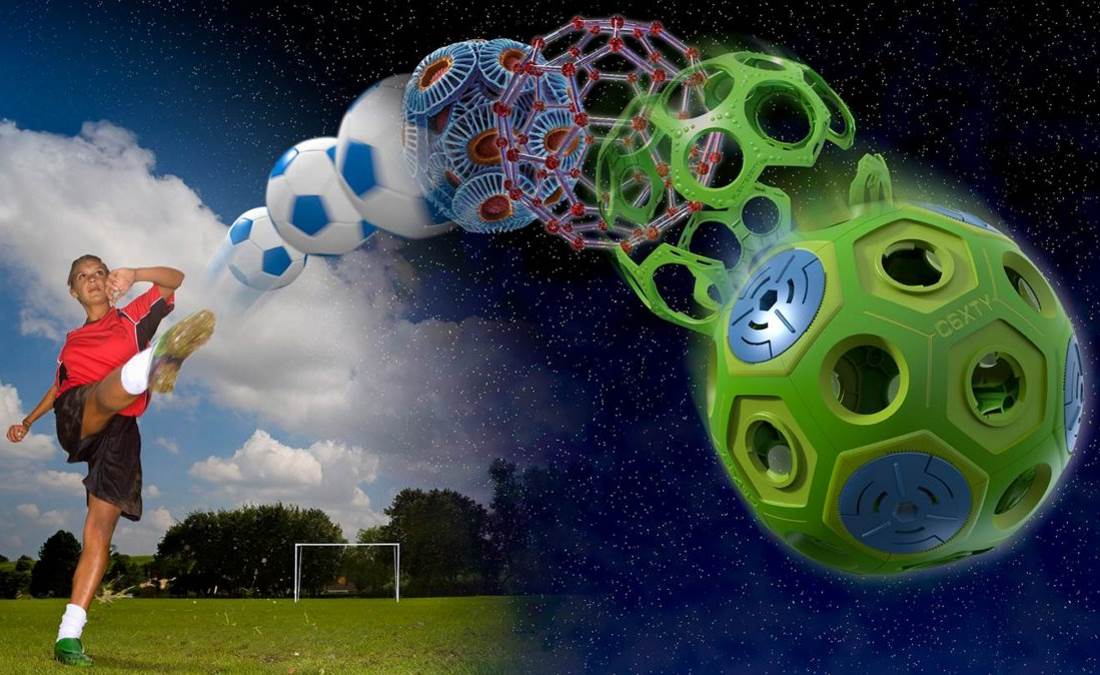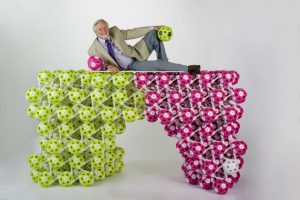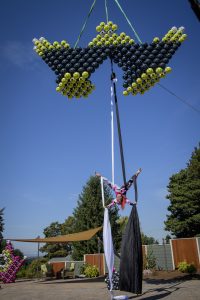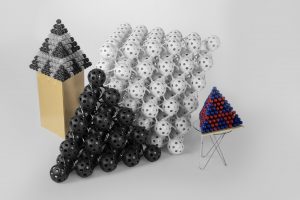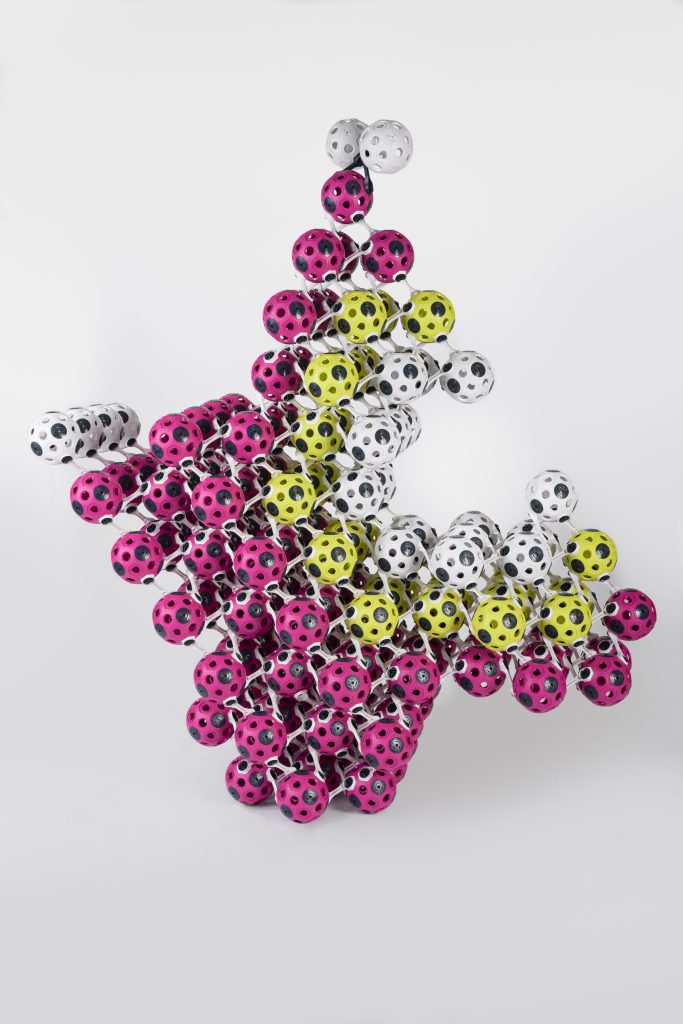We can create entirely new categories of materials and structures that are both strong / lightweight and accomplish the important goal of doing the most with the least by utilizing nature’s own geometry! C6XTY utilizes the familiar shape of the soccer ball, which is also known as a Fullerene or Carbon 60 molecule. This molecule because of its unique geometry is inherently stable, making it well suited for carrying loads in compression much like a ball bearing. Solutions to problems can be manufactured at any scale, from almost any substance for a wide variety of applications such as muscle replacements, computer memory to retaining walls, housing, and bridges.
Both the icosahedron and the truncated icosahedron express fivefold symmetry and are stable geometric structures. They are naturally related to one another. The archetype of the truncated icosahedron is the celebrated C60 molecule. Fullerenes (hereinafter I will use C60, Fullerenes, soccer balls and truncated icosahedron interchangeably) are closed carbon cage molecules containing only 12 pentagonal and 20 hexagonal rings. Of the 1800+ isomers of fullerenes, the C60- so called because it has sixty vertices- is the most stable of all because the distance between the pentagons and hexagons is uniform, thereby making it stable.
There are many examples of icosahedral and truncated icosahedral structures found in nature. Certain shapes are well suited for microbiological tasks and persist within organisms where identical, spontaneously assembling protein subunits tend to form symmetrical, minimum-energy shapes. One shape that occurs in several contexts is the icosahedron as presented in the preceding chapters. A common feature among the icosahedral structures found in microbiology is that they control permeability. Some of these structures, in viruses, for example, may be nearly impermeable, protecting their contents from damaging outside influences and allowing small entities with limited genetic resources to construct viable outer casings. In other cases, icosahedral forms screen molecules, allowing only molecules of a certain size access to vital cellular resources and mechanisms. Other icosahedral structures do not limit access but form a scaffolding to support and guide important cellular functions.
Viruses with icosahedral capsids range approximately from 20-300 nm in diameter and have genomes that range approximately from 5-350 kb in length. Several constraints lead to the icosahedral shape in viral capsids. Viral genomes are small and only provide a very small amount of space for the coding of capsid proteins. As a result, capsids are generally constructed from a small number of identical units, which assemble themselves into symmetrical structures.
Other examples of how nature uses structure to serve many purposes: Inclusion bodies are compartments that form within cells, usually during certain growth phases or under particular environmental conditions. They are often polyhedral and are usually found in prokaryotic organisms but may also be found in some eukaryotes. Their purpose is generally to store, transport, or sequester material within cells or to sequester certain reactions within the cytoplasm. This isolates the contents from the rest of the cytoplasm and may also regulate any encapsulated reactions. Using icosahedra to divide space and control access is very efficient and seems to be preferred in many contexts where resources are severely limited.
Inclusion bodies may be icosahedral but also assume a wide variety of other forms. They are generally on the order of 50-100 nm in diameter. There are many different types of inclusion bodies. Some interesting examples are carboxysomes, gas vesicles, magnetosomes, and symbiotic virus particles. Carboxysomes are centers for carbon fixation. They are usually filled with the enzyme RuBisCO, which catalyzes the key reaction of the Calvin-Benson-Bassham cycle. The Calvin-Benson-Bassham cycle comprises the dark reactions of photosynthesis.
The truncated icosahedron forms naturally and relatively easily from many biochemical compounds and has numerous features that have proven their usefulness through the evolutionary process of selection. An example of the truncated icosahedral structure in nature is Clathrin, which is a trimeric protein (three identically similar molecules) with a triskelion shape. It spontaneously assembles into pentagonal and hexagonal shapes that combine to form spherical polyhedra. It generally forms vesicles that engulf extracellular material in the process of bringing substances into the interior of the cell at the cell surface. When triskelia assemble together in solution, they can interact with enough flexibility to form 6-sided rings (hexagons) that yield a flat lattice, or 5-sided rings (pentagons) that are necessary for curved lattice formation. When many triskelions connect, they can form a basket-like structure. To enclose a vesicle, exactly 12 pentagons must be present in the lattice. They will bind to other membrane-attached triskelia to form a rounded lattice of hexagons and pentagons, reminiscent of the panels on a soccer ball that pulls the membrane into a bud. By constructing different combinations of 5-sided and 6-sided rings, vesicles of different sizes may assemble.
We can now take natures geometry, scale it, use suitable materials and create nearly limitless applications of yet unforeseen utility. That is where C6XTY’s lattice is the elegant ‘almost universal fabric’ based on Buckminster Fuller’s observation that compression can be thought of as ‘islands’ in a sea of tension. Tension and compression can be arranged in a uniform lattices [Snelson, Fuller, Lanahan].
Tension and compression- the yin and yang of structure are inseparable. While they can be thought of as being in opposition to one another, they can also be tamed into a harmonious relationship. That is accomplished through triangulation. Compression is triangulated in tension. That is the key, because stable structures are triangulated. This arrangement of tension and compression results in a uniform lattice that can be optimized for the specific application.

